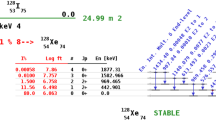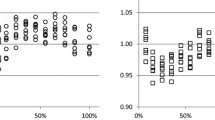Abstract
We have investigated the severity of interferences in the determination of lutetium in neutron activation analysis. The preferred reaction makes use of the large radiative capture cross section of 2090 b for 176Lu(n,γ)177Lu, which emits a 208.4 keV gamma emission (t1/2 = 6.73 days). Activation of 176Lu simultaneously produces 177mLu, which also emits at 208.4 keV (t1/2 = 160.4 days). We found that these convolutions did not produce significant error in lutetium analysis for a sample of NIST 1633c, even for longer decay times used to reduce the 239Np interference at 209.8 keV.




Similar content being viewed by others
References
Cimpan C, Kennedy G (2016) Measurement of k0 and Q0 values for lutetium and europium. J Radioanal Nucl Chem 309:173–178
Sluijis Van (2014) A simplified method to replace the Westcott formalism in ko-NAA using non-1/v nuclides. J Radioanal Nucl Chem 300:539–545
Sluijis Van (2019) The Westcott convention converted in the extended version of the modified Høgdahl convention. J Radioanal Nucl Chem 319:1277–1282
Cánovas CR, Chapron S, Arrachart G, Pellet-Rostaing S (2019) Leaching of rare earth elements (REEs) and impurities fromphosphogypsum: a preliminary insight for further recovery of critical raw materials. J Clean Prod 219:225–235
Borges RC, Favaro DIT, Caldas VG, Lauria DC, Bernedo AVB (2016) Instru-mental neutron activation analysis, gamma spectrometry and geographic in-formation system techniques in the determination and mapping of rare earth element in phosphogypsum stacks. Environ Earth Sci 75:705
Jimenez-Reyes M, Tenorio D, Esparza JR, Cruz-Jiménez RL, Mandujano C, Elizalde S (2000) Neutron activation analysis of obsidians from quarries of the Central Quaternary Trans-Mexican Volcanic Axis. J Radioanal Nucl Chem 250:465–471
Neisiani MA, Latifi M, Chaouki J, Chilian C (2018) Novel approach in ko-NAA for highly concentrated REE samples. Talanta 180:403–409
Orvini E, Speziali M, Salvini A, Herborg C (2000) Rare earth elements determination in environmental matrices by INAA. Microchem J 67:97–104
Silachyov I (2016) Rare earths analysis of rock samples by instrumental neutron activation analysis, internal standard method. J Radioanal Nucl Chem 310:573–582
Brunfelt AO, Roelandts I (1973) Determination of rare earths and thorium in apatites by thermal and epithermal neutron-activation analysis. Talanta 21:513–521
Krane KS (1987) Introductory Nuclear physics. Wiley, New York
Currie LA (1968) Limits for qualitative detection and quantitative determination, application to radiochemistry. Anal Chem 40:586–593
Author information
Authors and Affiliations
Corresponding author
Additional information
Publisher's Note
Springer Nature remains neutral with regard to jurisdictional claims in published maps and institutional affiliations.
Rights and permissions
About this article
Cite this article
Brennan, C., Landsberger, S. Interferences in the determination of lutetium using neutron activation analysis. J Radioanal Nucl Chem 322, 1201–1205 (2019). https://doi.org/10.1007/s10967-019-06674-8
Received:
Published:
Issue Date:
DOI: https://doi.org/10.1007/s10967-019-06674-8




